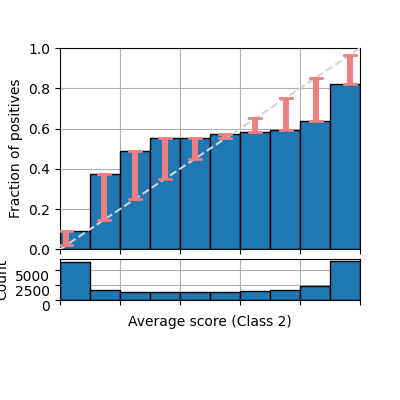Note
Go to the end to download the full example code. or to run this example in your browser via Binder
Quickstart
This example shows a simple comparison of the expected calibration error of a non-calibrated method against a calibrated method.
# Author: Miquel Perello Nieto <miquel.perellonieto@bristol.ac.uk>
# License: new BSD
print(__doc__)
First choose a classifier
from sklearn.naive_bayes import GaussianNB
clf = GaussianNB()
And a dataset
from sklearn.datasets import make_classification
from sklearn.model_selection import train_test_split
X, y = make_classification(
n_samples=100000, n_features=20, n_informative=4, n_redundant=4,
random_state=42
)
from sklearn.model_selection import train_test_split
X_train, X_test, Y_train, Y_test = train_test_split(X, y)
We can see how calibrated it is after training
clf.fit(X_train, Y_train)
n_correct = sum(clf.predict(X_test) == Y_test)
n_test = Y_test.shape[0]
print(f"The classifier gets {n_correct} correct "
f"predictions out of {n_test}")
The classifier gets 17938 correct predictions out of 25000
We can asses the confidence expected calibration error
The classifier gets a confidence expected calibration error of 0.13
Let’s look at its reliability diagram
from pycalib.visualisations import plot_reliability_diagram
plot_reliability_diagram(labels=Y_test, scores=scores, show_histogram=True,
show_bars=True, show_gaps=True)

<Figure size 400x400 with 2 Axes>
We can see how a calibration can improve the conf-ECE
from pycalib.models import IsotonicCalibration
cal = IsotonicCalibration()
Now we can put together a probabilistic classifier with the chosen calibration method
from pycalib.models import CalibratedModel
cal_clf = CalibratedModel(base_estimator=clf, calibrator=cal,
fit_estimator=False)
Now you can train both classifier and calibrator all together.
cal_clf.fit(X_train, Y_train)
n_correct = sum(cal_clf.predict(X_test) == Y_test)
print(f"The calibrated classifier gets {n_correct} "
f"correct predictions out of {n_test}")
scores_cal = cal_clf.predict_proba(X_test)
cece = conf_ECE(Y_test, scores_cal, bins=15)
print(f"The calibrated classifier gets a confidence "
f"expected calibration error of {cece:0.2f}")
The calibrated classifier gets 18213 correct predictions out of 25000
The calibrated classifier gets a confidence expected calibration error of 0.01
Now you can train both classifier and calibrator all together.
from pycalib.visualisations import plot_reliability_diagram
plot_reliability_diagram(labels=Y_test, scores=scores_cal, show_histogram=True,
show_bars=True, show_gaps=True)

<Figure size 400x400 with 2 Axes>
Total running time of the script: (0 minutes 0.712 seconds)